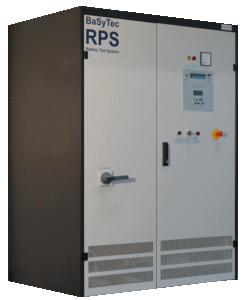RPS: Battery Pack Test System
Optimised for electric vehicles, large batteries and high power batteries, the BaSyTec RPS offers up to 600 A and 1000 V. Parallel operation allows up 1.5MW of power and the energy recovery offers efficiency up to 95% during discharge. The optional CMU Datalogger with up to 4800 inputs for temperatures and voltages makes this system ideal for research battery packs with large number of individual cells.
Key features include:
- Charge and discharge current of up to 600A
- Voltage of up to 1000V
- Continuous power of up to 400kW
- Current rise time below 5ms
- Energy recovery while discharging with high efficiency
- Batteries connected in four wire method
- Low current ripple of below 0.3%
- Low line perturbation by use of power factor correction
- Battery Safety Device for independent battery monitoring and emergency shut-off
- Interfaces for climate chamber and other third party devices e.g. BMS systems
- Interface to superordinate safety concept
- CMU Datalogger with up to 4800 inputs for temperatures and voltages available
- Optional burst generator to stress battery monitoring systems
- Operated by well-known BaSyTest Software
RPS Specification
- Power: up to 500kW (1.5MW in parallel operation)
- Voltage range: up to 1000V
- Voltage precision: 0.05% FS
- Voltage resolution: 16 bit full scale
- 4-wire measurement: Yes
- Min. discharge voltage: 5V
- Current precision: 0.05% FS
- Current resolution: 16 Bit
- Current range (charge and discharge) per channel (can be paralleled): up to 1000A (3000A in parallel operation)
- Number of current ranges per channel: 2 Max
- Add. inputs per channel: 2 x PT 100/4-wire temperature, with optional others
- Inputs/BSD HV: Voltage, current 2 x PT 100/4-wire temp, 4 x 0-10V (for sensors)
- Time resolution: 1 us
- Minimum pulse length: 1 ms
Applications:
- Life cycle tests of battery modules and battery systems
- Parameter tests of battery modules and battery systems
- Application oriented tests
- Simulation of current profiles with high current dynamic
- Double layer capacitor testing
RPS Technology
A modern IGBT rectifier/inverter followed by a fast chopper is the basis of the RPS system. This technology allows energy recovery back to the power line whilst discharging, in combination with a fast response time and a low current ripple. The presence of a transformer guarantees the galvanic isolation from the power line. Given that the nominal efficiency of the energy recovery is 95%, the system offers many advantages over other comparable systems. Advantages include:
- Lower heat dissipation
- Lower direct energy costs
- Smaller size
- Lower indirect costs for air condition
Reliability
The control electronics and software is the approved BaSyTec system, which operates at a very high reliability thanks to the embedded control, working independently from the operation of a PC and networks. The test procedure is transmitted to the test system and is executed in an embedded controller. System failures are detected via a hierarchical watchdog system, which shuts the system down in undefined conditions. Battery signals including voltage, current, temperatures etc, are monitored by an independent battery safety device. If any signal exceeds it’s limit, an emergency stop is triggered.
Battery Simulation
The BaSyTec RPS battery test system is able to provide a CAN interface where output and internal resistance can be set dynamically, allowing the RPS system to be used as a battery simulator or power supply. This is achieved by switching the battery test system to act as a bipolar laboratory power supply, where the output voltage, resistance and current limits are set at the display and the keys on the front panel.
BaSyTest Software is used to:
- Define test procedures
- Control the battery test system
- Monitor running tests
- Analyse test results
- The software offers constant current, voltage and power control modes, in addition to constant resistance for discharging.

